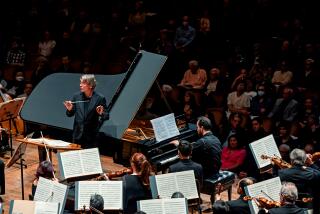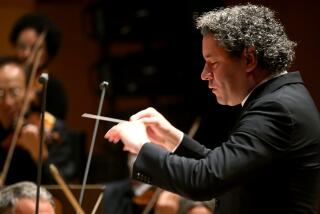For fans of early piano, it’s hip to be square
- Share via
“The World’s First Piano Concertos”
David Owen Norris (square piano), Sonnerie (Monica Huggett, Emilia Benjamin, violins; Joseph Crouch, cello). (Avie)
** 1/2
The eye-catching title notwithstanding, the main attraction of this disc is a long-neglected instrument called the square piano -- not the ill-tuned 19th century behemoths that crowd American antique stores, but an earlier, smaller instrument designed by Johannes Zumpe in 1766. Norris has conjectured that Johann Christian Bach and other composers fashioned some of their concertos for this delicate keyboard -- so he performs six of them on two surviving examples, backed only by three baroque string players. It certainly is a different sound; the square piano has a gently jangling tone like that of a hammer dulcimer, or even a banjo at times. The notes sustain uncontrollably until the player can free one hand to stop them with a lever. That huge flaw automatically limits this piano to specialized repertoire -- and of the modestly inspired pieces assembled here, the freshest comes from the obscure pen of James Hook.
-- Richard S. Ginell
Eliciting Dvorak’s many colors
Dvorak: Violin Concerto in A minor; Piano Quintet
Sarah Chang, violin. Also Alexander Kerr, violin; Wolfram Christ, viola; Georg Faust, cello; Leif Ove Andsnes, piano. London Symphony. Colin Davis, conductor. (EMI Classics)
***
Two of Dvorak’s most tuneful works are here accorded colorful performances. In the concerto, Chang distinguishes herself with solid virtuosity and emotional cohesion. She is felicitously seconded by Davis and the orchestra. Andsnes gives a rippling and effortless account of the piano part in the Second Quintet. The string players work hard, but seldom achieve the work’s true mellowness.
-- Daniel Cariaga
African sounds as inspirations
Ligeti/Reich: “African Rhythms”
Pierre-Laurent Aimard, piano, AKA Pygmies (Teldec)
** 1/2
Good intentions line this cultural cross-stitch project, but nagging contextual questions keep interrupting the fluidity of the listening experience. The idea was to blend, on one CD, the rhythmically intensive piano music of Gyorgy Ligeti, the pulse-driven minimalism of Steve Reich and the undulant, riveting polyrhythmic sound of the AKA Pygmies of Central Africa, representing an ancient source of rhythmic inspiration for Ligeti, Reich and countless other world-attuned composers. Reich serves primarily as a framing device in the program, with his unabashedly African-influenced “Clapping Music” and “Music for Pieces of Wood” serving as bookends for the series of engaging Ligeti piano etudes and Pygmy recordings, compelling in their own right. Still, Ligeti’s etudes, played with exacting fervor by Aimard, are the real meat of the set. The jarring contrast of these pieces and Pygmy music -- akin to a Picasso exhibit that also includes African art for context -- sounds better on paper.
-- Josef Woodard
‘Harold’ in the French style
Berlioz: “Harold en Italie”
Tabea Zimmermann, viola. London Symphony. Colin Davis, conductor. (LSO Live)
** 1/2
Davis has a formidable reputation as a Berlioz interpreter, but it’s one that’s not universally agreed upon. Here, he seems more intent on fast tempos and clear, light textures than in exploring expansive or brooding emotions, the Byronic qualities one would deem essential in the particular piece -- inspired by the 19th century poet’s “Childe Harold’s Pilgrimage” -- by this singular and innovative composer. Davis’ “French” approach, putting emphasis on distinct and clear orchestral colors, doesn’t allow much personal voice to the fine viola soloist, Zimmermann, who represents the title character. Similarly, a sense of 18th century lightness and delicacy hovers over four ballet excerpts (one of which includes an unidentified children’s chorus) from Berlioz’s massive opera “Les Troyens.”
-- Chris Pasles
Albums are rated on a scale from one star (poor) to four stars (excellent).
More to Read
The biggest entertainment stories
Get our big stories about Hollywood, film, television, music, arts, culture and more right in your inbox as soon as they publish.
You may occasionally receive promotional content from the Los Angeles Times.










